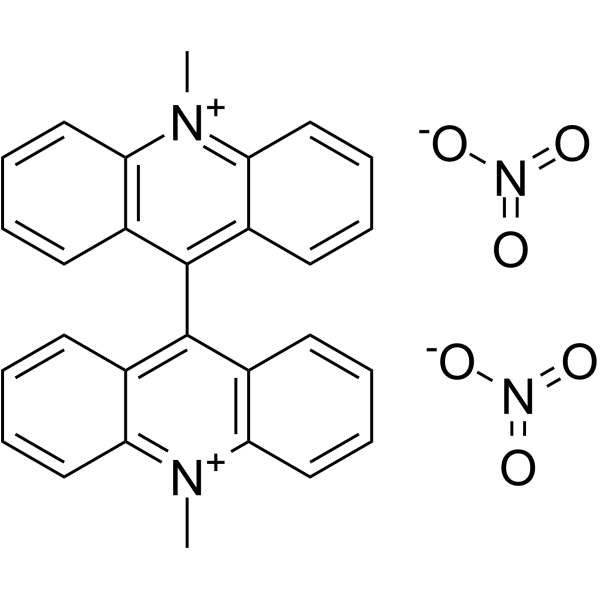All AbMole products are for research use only, cannot be used for human consumption.

Lucigenin(L-6868; NSC-151912) is a chemiluminescent probe used to indicate the presence of endogenously generated superoxide anion radicals in cells. Upon single-electron reduction of Lucigenin by a radical species the subsequent form of Lucigenin presents an amplified chemiluminescence which is measurable and can be correlated to the respective amount of reactive radical species present in the system. This approach can be used to probe the natural generation of these species as well as the natural functioning of superoxide dismutase and other enzymes responsible for scavenging radicals. In addition to indicating the presence of radicals in cells, Lucigenin shows interaction with redox-active oxidoreductase enzymes. Lucigenin is shown to mediate the reduction of cytochrome C by xanthine oxidase and to increase the rate of NADPH oxidation. These observations indicate that use of Lucigenin for superoxide analysis is precluded in the presence of high levels of NAD(P)H-oxidoreductases.
| Molecular Weight | 510.5 |
| CAS Number | 2315-97-1 |
| Solubility (25°C) | DMSO 62.5 mg/mL |
| Storage | 2-8°C, protect from light, dry, sealed |
| Related Fluorescent Dye Products |
|---|
| N-Succinimidyl 6-(2,4-Dinitroanilino)hexanoate
N-Succinimidyl 6-(2,4-Dinitroanilino)hexanoate, the DNP-X acid modified by succinimidyl ester, is an amine-reactive building block for developing a probe, which can be recognized by anti-DNP antibodies. |
| FITC-Arachidonic Acid
FITC-Arachidonic Acid is a fluorescent labelled compound for biomedical research. FITC-Arachidonic Acid combines the biological activity of arachidonic acid and the fluorescent properties of FITC, and is suitable for the study of cellular signalling, lipid metabolism and so on. |
| Arachidonic acid-biotin
Arachidonic acid-Biotin is a biotin-labeled Arachidonic acid that can be used to detect complexes of arachidonic acid with protein binding partners such as fatty acid binding proteins (FABPs). |
| 4-methylumbelliferyl α-D-glucopyranoside
4-Methylumbelliferyl-α-D-Glucopyranoside is a fluorescent substrate for α-glucosidase (GAA), which releases the fluorescent moiety 4-methylumbelliferyl (4-MU) upon cleavage. 4-MU has pH-dependent fluorescence excitation activity, with excitation wavelengths of 320 nm at low pH (1.97-6.72) and 360 nm at high pH (7.12-10.3), respectively. |
| Cyanine7 amine
Cyanine7 amine is a near infrared dye with free amine group for the conjμgation with activated esters and other reactive molecules. |
All AbMole products are for research use only, cannot be used for human consumption or veterinary use. We do not provide products or services to individuals. Please comply with the intended use and do not use AbMole products for any other purpose.


Products are for research use only. Not for human use. We do not sell to patients.
© Copyright 2010-2024 AbMole BioScience. All Rights Reserved.
